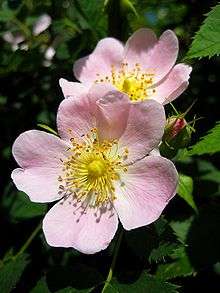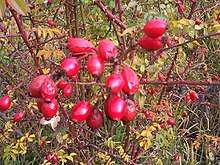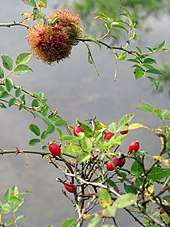Rosa canina
Rosa canina, commonly known as the dog rose,[1] is a variable climbing, wild rose species native to Europe, northwest Africa, and western Asia.
| Rosa canina | |
|---|---|
 | |
| Rosa canina flowers are sometimes pink | |
| Scientific classification | |
| Kingdom: | Plantae |
| Clade: | Tracheophytes |
| Clade: | Angiosperms |
| Clade: | Eudicots |
| Clade: | Rosids |
| Order: | Rosales |
| Family: | Rosaceae |
| Genus: | Rosa |
| Species: | R. canina |
| Binomial name | |
| Rosa canina | |
| Synonyms | |
|
See text | |
It is a deciduous shrub normally ranging in height from 1–5 metres (3.3–16.4 ft), though sometimes it can scramble higher into the crowns of taller trees. Its stems are covered with small, sharp, hooked prickles, which aid it in climbing. The leaves are pinnate, with 5–7 leaflets. The flowers are usually pale pink, but can vary between a deep pink and white. They are 4–6 centimetres (1.6–2.4 in) in diameter with five petals, and mature into an oval, 1.5–2-centimetre (0.59–0.79 in), red-orange fruit, or hip.
Synonyms
From DNA analysis using amplified fragment length polymorphisms of wild-rose samples from a transect across Europe (900 samples from section Caninae, and 200 from other sections), it has been suggested that the following named species are best considered as part of a single Rosa canina species complex, and are therefore synonyms of R. canina:[2]
- R. balsamica Besser
- R. caesia Sm.
- R. corymbifera Borkh.
- R. dumalis Bechst.
- R. montana Chaix
- R. stylosa Desv.
- R. subcanina (Christ) Vuk.
- R. subcollina (Christ) Vuk.
- R. × irregularis Déségl. & Guillon
Cultivation and uses


The flesh (shells) of rose hips from dog roses contain high levels of antioxidants, mainly polyphenols and ascorbic acid, as well as carotenoids and vitamins B and E.[3] Rose hips contain a high amount of carotenoids and ascorbic acid along with natural sugars, organic acids, polyunsaturated fatty acids, phenolics, and essential oil, making them excellent for consumption. Rose hip essential oil is composed mainly of alcohols, monoterpenes and sesquiterpenes.[4]
The fruit is noted for its high level of vitamin C, and is used to make syrup, tea, and marmalade. It has been grown or encouraged in the wild for the production of vitamin C from its fruit (often as rose-hip syrup), especially during conditions of scarcity or during wartime. The species has also been introduced to other temperate latitudes. During World War II in the United States, Rosa canina was planted in victory gardens, and can still be found growing throughout the country, including roadsides and in wet, sandy areas along the coastlines.
In Bulgaria, where it grows in abundance, the hips are used to make a sweet wine as well as tea. In the traditional Austrian medicine, Rosa canina fruits have been used internally as tea for treatment of viral infections and disorders of the kidneys and urinary tract.[5] The hips are used as a flavouring in Cockta, a soft drink made in Slovenia.
Bao Ninh in "The Sorrow of War," his novel of the Vietnam War from a North Vietnamese soldier's perspective, writes: "With canina one smoked to forget the daily hell of the soldier's life, smoked to forget hunger and suffering. Also, to forget death. And totally, but totally, to forget tomorrow."
Forms of this plant are used as stocks for the grafting or budding of cultivated roses. The wild plant is used for stabilising soil in land reclamation and specialised landscaping schemes.
Numerous cultivars have been named, though few are common in cultivation. The cultivar Rosa canina 'Assisiensis' is the only dog rose without thorns.
The flower is one of the national symbols of Romania.
Medicinal use
Medicinal interest in rose hips has increased as a consequence of research that has explored the potential application of rose hips for treatment of several diseases including skin disorders, hepatotoxicity, renal disturbances, diarrhoea, inflammatory disorders, arthritis, diabetes, hyperlipidaemia, obesity and cancer. In history, residue products from rose hips have been used as animal fodder, but now are being explored and gaining an important role in cosmetics, pharmacology and in food applications as they contain oil with a high degree of unsaturated lipids.[6]
An experiment was done in Italy by the Department of Pharmacology at Bologna University, to test the anti-inflammatory and gastroprotective effects of crude extract from the Rosa Canina (dog rose) on a rat. The data showed that Gastric damage was lower in rat stomachs that had been pretreated by the Rosa canina extract and chemical analysis revealed that the extract contributed to having anti-inflammatory effects. It concluded that the anti-inflammatory property of Rosa canina suggested a potential role in the management of inflammatory-related diseases.[7]
Culinary use
The fruit is used in the making of pies, stews, and wine. The flowers can be made into a syrup,[8] or can be eaten in salads, or candied or preserved in vinegar, honey and brandy.[9]
Canina meiosis

The dog roses, the Canina section of the genus Rosa (20-30 species and subspecies, which occur mostly in Northern and Central Europe), have an unusual kind of meiosis that is sometimes called permanent odd polyploidy, although it can occur with even polyploidy (e.g. in tetraploids or hexaploids). Regardless of ploidy level, only seven bivalents are formed leaving the other chromosomes as univalents. Univalents are included in egg cells, but not in pollen.[10][11] Similar processes occur in some other organisms.[12] Dog roses are most commonly pentaploid, i.e. five times the base number of seven chromosomes for the genus Rosa, but may be tetraploid or hexaploid as well.
Name and etymology
The botanical name is derived from the common names 'dog rose' or similar in several European languages, including classical Latin and ancient (Hellenistic period) Greek.
It is sometimes considered that the word 'dog' has a disparaging meaning in this context, indicating 'worthless' as compared with cultivated garden roses.[13] According to The Oxford Dictionary of Phrase and Fable,[14] the English name is a direct translation of the plant's name from classical Latin, rosa canina, itself a translation of the Greek κυνόροδον ('kunórodon'); the name arose out of the belief in classical times that the root was a cure for the bite of a mad dog. It is known to have been used to treat the bite of rabid dogs in the 18th and 19th centuries.[15] The origin of its name may be related to the hooked prickles on the plant that have resemblance to a dog's canines.[16]
The Roman naturalist Pliny attributed the name dog rose to a belief that the plant's root could cure the bite of a mad dog. It is not clear if the dogs were rabid.[17]
Other old folk names include dogberry and witches' briar.
Invasive species
Dog rose is an invasive species in the high country of New Zealand. It was recognised as displacing native vegetation as early as 1895[18] although the Department of Conservation does not consider it to be a conservation threat.[19]
The dog rose is a declared weed in Australia under the Natural Resources Management Act 2004 (NRM Act) as the plant out-competes native vegetation, provides shelter to pests such as foxes and rabbits, is unpalatable to stock, large shrubs are resistant to grazing, therefore do not get eaten by farm animals. The dog rose also invades native bushland therefore reducing biodiversity and the presence of desirable pasture species. It is also a biosecurity risk as it hosts fruit fly.[20]
Birds and wild fruit eating animals are the main cause of seed dispersal. The plant seeds can also be carried in the hooves or fur of stock animals. They may also be carried by waterways.[21]
In culture

The dog rose was the stylised rose of medieval European heraldry.[22] It is the county flower of Hampshire,[23] and Ireland's County Leitrim is nicknamed "The Wild Rose County" due to the prevalence of the dog rose in the area. Legend states the Thousand-year Rose or Hildesheim Rose, which climbs against a wall of Hildesheim Cathedral, dates back to the establishment of the diocese in 815.[24]
The first recorded significance of the flower dates back hundreds of years ago to The Academy of Floral Games (founded in 1323), which gifted poets a sprig of Dog-rose to reward them for their literary excellence. Due to this ritual, the branches became increasingly popular and can be found frequently mentioned in several famous poems. Most prevalent in the United Kingdom, William Shakespeare wrote about the flower in "A Mid-Summer Night's Dream",[25] which in his time was called eglantine, though it can now also refer to Rosa rubiginosa (Sweet brier)[26]
Oberon, A Midsummer Night's Dream, Act II, Scene I quoting his words:"With sweet musk-roses and with eglantine."
Symbolically, the meaning of this shrub is quite extensive since the two dominating themes surrounding the flower are pain and pleasure.[27]
An old riddle, 'The Five Brethren of the Rose',
On a summer's day, in sultry weather
Five Brethren were born together
Two had beards and two had none
And the other had but half a one."
The riddle contains an effective way of identifying the differing roses of the canina group, where the brethren' refers to the five sepals of the dog-rose, two of which are whiskered on both sides, two quite smooth and the last one whiskered on one side only.[28]
References
- "Rosa canina (S) dog rose". Royal Horticultural Society. Retrieved 2017-04-04.
- De Riek, Jan; De Cock, Katrien; Smulders, Marinus J.M.; Nybom, Hilde (2013). "AFLP-based population structure analysis as a means to validate the complex taxonomy of dog roses (Rosa section Caninae)". Molecular Phylogenetics and Evolution. 67 (3): 547–559. doi:10.1016/j.ympev.2013.02.024. PMID 23499615.
- Nybom, Hilde; Werlemark, Gun (2017). "Realizing the Potential of Health-Promoting Rosehips from Dogroses (Rosa sect. Caninae)". www.ingentaconnect.com. Retrieved 20 November 2019.
- Ahmad, Naveed; Anwar, Farooq; Gilani, Anwar-ul-Hassan (1 January 2016). "Chapter 76 - Rose Hip (Rosa canina L.) Oils". Essential Oils in Food Preservation, Flavor and Safety. Academic Press. pp. 667–675. Retrieved 20 November 2019.
- Vogl, Sylvia; Picker, Paolo; Mihaly-Bison, Judit; Fakhrudin, Nanang; Atanasov, Atanas G.; Heiss, Elke H.; Wawrosch, Christoph; Reznicek, Gottfried; Dirsch, Verena M.; Saukel, Johannes; Kopp, Brigitte (2013). "Ethnopharmacological in vitro studies on Austria's folk medicine—An unexplored lore in vitro anti-inflammatory activities of 71 Austrian traditional herbal drugs". Journal of Ethnopharmacology. 149 (3): 750–771. doi:10.1016/j.jep.2013.06.007. PMC 3791396. PMID 23770053.
- Mármol, Inés; Sánchez-de-Diego, Cristina; Jiménez-Moreno, Nerea; Ancín-Azpilicueta, Carmen; Rodríguez-Yoldi, María Jesús (25 May 2017). "Therapeutic Applications of Rose Hips from Different Rosa Species". International Journal of Molecular Sciences. 18 (6): 1137. doi:10.3390/ijms18061137. PMC 5485961. PMID 28587101.
- Lattanzio, Francesca; Greco, Emanuela; Carretta, Donatella; Cervellati, Rinaldo; Govoni, Paolo; Speroni, Ester (1 September 2011). "In vivo anti-inflammatory effect of Rosa canina L. extract". Journal of Ethnopharmacology. 137 (1): 880–885. doi:10.1016/j.jep.2011.07.006. PMID 21771653.
- "Rosehip - A Foraging Guide to Its Food and Medicine". EATWEEDS. 2 December 2018. Retrieved 18 November 2019.
- "Rosehip - A Foraging Guide to Its Food and Medicine". EATWEEDS. 2 December 2018. Retrieved 18 November 2019.
- Täckholm, Gunnar (1922). "Zytologische Studien über die Gattung Rosa". Acta Horti Bergiani. 7: 97–381.
- Lim, K Y; Werlemark, G; Matyasek, R; Bringloe, J B; Sieber, V; El Mokadem, H; Meynet, J; Hemming, J; Leitch, A R; Roberts, A V (2005). "Evolutionary implications of permanent odd polyploidy in the stable sexual, pentaploid of Rosa canina L". Heredity. 94 (5): 501–506. doi:10.1038/sj.hdy.6800648. PMID 15770234.
- Stock, M.; Ustinova, J.; Betto-Colliard, C.; Schartl, M.; Moritz, C.; Perrin, N. (2011). "Simultaneous Mendelian and clonal genome transmission in a sexually reproducing, all-triploid vertebrate". Proceedings of the Royal Society B: Biological Sciences. 279 (1732): 1293–9. doi:10.1098/rspb.2011.1738. PMC 3282369. PMID 21993502.
- Vedel, Helge. (©1960, reprinted 1962). Trees and bushes in wood and hedgerow. Lange, Johan. London: Methuen. ISBN 0-416-61780-8. OCLC 863361796. Check date values in:
|date=(help) - Elizabeth Knowles (2005). "The Oxford Dictionary of Phrase and Fable" (2nd ed.). Oxford University Press.
- Howard, Michael. Traditional Folk Remedies (Century, 1987); p.133
- "Properties of dog rose". Botanical online. 19 January 2019. Retrieved 21 November 2019.
- Haas, L F (November 1995). "Rosa canina (dog rose)". Journal of Neurology, Neurosurgery, and Psychiatry. 59 (5): 470. doi:10.1136/jnnp.59.5.470. PMC 1073704. PMID 8530926.
- Kirk, T (1895). "The Displacement of Species in New Zealand". Transactions of the New Zealand Institute. Wellington: Royal Society of New Zealand. 28. Retrieved 2009-04-17.
- Owen, S. J. (1997). Ecological weeds on conservation land in New Zealand: a database. Wellington: Department of Conservation.
- [ile:///D:/Downloads/wild-rose-fact-sheet.pdf "Wild rose"] Check
|url=value (help) (PDF). Government of South Australia. Retrieved 21 November 2019. - "Pest plant - Dog rose and sweet briar rose - Department of Environment, Water and Natural Resources". www.naturalresources.sa.gov.au. Retrieved 19 November 2019.
- Carol Klein Wild Flowers: Nature's own to garden grown, p. 104, at Google Books
- "Dog-rose". Plantlife. Retrieved 2018-07-04.
- Lucy Gordan. "Hildesheim's Medieval Church Treasures at the Met". Inside the Vatican. Archived from the original on 3 May 2014. Retrieved 30 April 2014.
- Canale, Suzie. "The Meaning of the Dog-rose". blog.exoticflowers.com. Retrieved 20 November 2019.
- "Dog-rose". Plantlife. Retrieved 17 November 2019.
- Canale, Suzie. "The Meaning of the Dog-rose". blog.exoticflowers.com. Retrieved 20 November 2019.
- "Dog-rose". Plantlife. Retrieved 20 November 2019.
Further reading
- Flora Europaea: Rosa canina
- Blamey, M. & Grey-Wilson, C. (1989). Flora of Britain and Northern Europe. Hodder & Stoughton. ISBN 0-340-40170-2.
- Vedel, H. & Lange, J. (1960). Trees and bushes. Metheun, London.
- Graham G.S. & Primavesi A.L. (1993). Roses of Great Britain and Ireland. B.S.B.I. Handbook No. 7. Botanical Society of the British Isles, London.
External links
| Wikimedia Commons has media related to Rosa canina. |